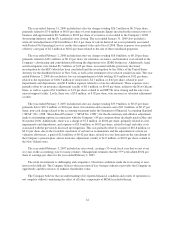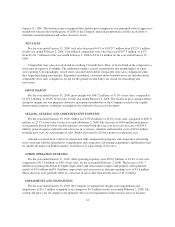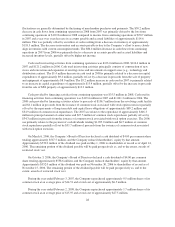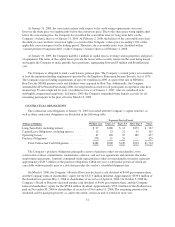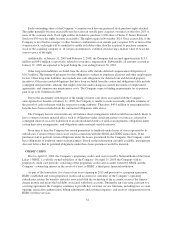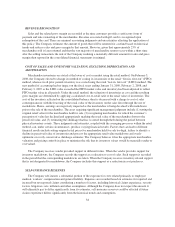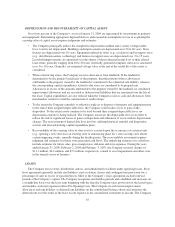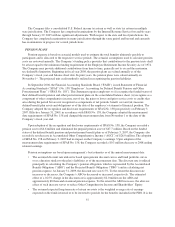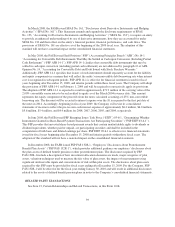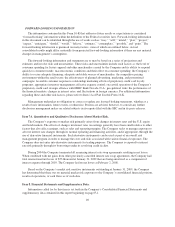Saks Fifth Avenue 2008 Annual Report Download - page 33
Download and view the complete annual report
Please find page 33 of the 2008 Saks Fifth Avenue annual report below. You can navigate through the pages in the report by either clicking on the pages listed below, or by using the keyword search tool below to find specific information within the annual report.Each outstanding share of the Company’s common stock has one preferred stock purchase right attached.
The rights generally become exercisable ten days after an outside party acquires, or makes an offer for, 20% or
more of the common stock. Each right entitles its holder to purchase 1/100 share of Series C Junior Preferred
Stock for $50 once the rights become exercisable. The rights expire in November 2018. Once exercisable, if the
Company is involved in a merger or other business combination or an outside party acquires 20% or more of the
common stock, each right will be modified to entitle its holder (other than the acquirer) to purchase common
stock of the acquiring company or, in certain circumstances, common stock having a market value of twice the
exercise price of the right.
Additionally, at January 31, 2009 and February 2, 2008, the Company had accrued approximately $13.9
million and $4.0 million, respectively, related to severance compensation. Substantially all amounts accrued at
January 31, 2009 are expected to be paid during the year ending January 30, 2010.
Other long-term liabilities excluded from the above table include deferred compensation obligations of
$10.3 million. The timing of payments for this obligation is subject to employee elections and other employment
factors. Other long-term liabilities also include non-cash obligations for deferred rent and deferred property
incentives. Other unrecorded obligations that have been excluded from the contractual obligations table include
contingent rent payments, amounts that might come due under change-in-control provisions of employment
agreements, and common area maintenance costs. The Company expects funding requirements for its pension
plan of up to $1.0 million in 2009.
Due to the uncertainty with respect to the timing of future cash flows associated with the Company’s
unrecognized tax benefits at January 31, 2009, the Company is unable to make reasonably reliable estimates of
the period of cash settlement with the respective taxing authority. Therefore, $45.0 million of unrecognized tax
benefits have been excluded from the contractual obligations table above.
The Company has not entered into any off-balance sheet arrangements which would be reasonably likely to
have a current or future material effect, such as obligations under certain guarantees or contracts; retained or
contingent interests in assets transferred to an unconsolidated entity or similar arrangements; obligations under
certain derivative arrangements; and obligations under material variable interests.
From time to time the Company has issued guarantees to landlords under leases of stores operated by its
subsidiaries. Certain of these stores were sold in connection with the SDSG and NDSG transactions. If the
purchasers fail to perform certain obligations under the leases guaranteed by the Company, the Company could
have obligations to landlords under such guarantees. Based on the information currently available, management
does not believe that its potential obligations under these lease guarantees would be material.
CREDIT CARDS
Prior to April 15, 2003, the Company’s proprietary credit cards were issued by National Bank of the Great
Lakes (“NBGL”), a wholly owned subsidiary of the Company. On April 15, 2003, the Company sold its
proprietary credit card portfolio, consisting of the proprietary credit card accounts owned by NBGL and the
Company’s ownership interest in the assets of a trust, to HSBC, a third party financial institution.
As part of the transaction, for a term of ten years expiring in 2013 and pursuant to a program agreement,
HSBC established and owns proprietary credit card accounts for customers of the Company’s operating
subsidiaries, retains the benefits and risks associated with the ownership of the accounts, receives the finance
charge income and incurs the bad debts associated with those accounts. During the ten-year term, pursuant to a
servicing agreement, the Company continues to provide key customer service functions, including new account
opening, transaction authorization, billing adjustments and customer inquiries, and receives compensation from
HSBC for these services.
32


